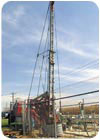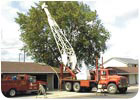
As part of the re-injection well rehabilitation and clean out, a worker pumps water from the well.
There are several ways that cost savings from well rehabilitation can be calculated. One method is to calculate the cost savings associated with reduced power requirements corresponding to a decreased water level drawdown within the well for a given pumping rate. Another method of determining the economics of the well rehabilitation is to calculate the benefit of the increase in available water supply from the well.

Systematic well rehabilitation using proper methods and materials usually can restore - or even increase - the specific capacity of the well.
Decreased Drawdown
The energy that a pump motor has to provide to a submersible pump decreases in proportion with decreasing water level drawdown. The electrical energy used by an electric motor coupled to a pump can be calculated given the pump discharge, the drawdown, the static water level and the pump and motor efficiency. The total cost of the energy is the unit energy cost multiplied by the units of energy used. The energy savings at a given flow rate, therefore, is calculated by subtracting the post-rehabilitation energy costs from the pre-rehabilitation energy costs at that flow rate.Increase in Supply
The benefit derived from the increased availability of ground water can be approximated by using the alternative cost method, which determines the cost of obtaining water from the next best source. Therefore, the benefit of obtaining water from a given source is approximated by subtracting the cost of obtaining water from that source from the cost of obtaining water from the next best source.Well Maintenance
Systematic well rehabilitation using proper methods and materials usually can restore - or even increase - the specific capacity of the well above the original and can maintain this specific capacity for a significant length of time. A methodical, long-range program of well inspection and monitoring is required to identify problems so that a regular program of preventative maintenance can guarantee a reliable source of water.Decisions, Decisions
Many economic factors, in addition to the intrinsic value of the water itself, should be taken into account when making the decision to rehabilitate an existing well or to construct a new one. These factors include: the direct cost for the rehabilitation program in comparison to the cost of a new well, the time required to rehabilitate an existing well or to drill and place a new well into service, the projected lifespan of the new well, the projected lifespan of the existing well if rehabilitated, the projected lifespan of the existing well if not rehabilitated and the costs of operating each well.Also, if the new well is completed in the same aquifer as the existing rehabilitated well, the problem likely will recur. In that case, the new well would require the same preventive maintenance program that the existing well would receive, or the new replacement well would be expected to fail at the same rate as the original.
Current well rehabilitation theory suggests that treatment or rehabilitation should take place as soon as there is a decrease in the well's performance. In any case, well rehabilitation procedures should be initiated before the specific capacity has declined 25 percent from the original specific capacity. Industry experience dictates that a well that has a specific capacity that is less than 75 percent of the original specific capacity often requires much larger expenditures for chemicals and labor without ever regaining the original performance. Often, it may be impossible to completely restore the original specific capacity of wells that are allowed to deteriorate further, even when using the best chemicals and rehabilitation techniques available.
This article is provided through the courtesy of the Prairie Farm Rehabilitation Administration.


Report Abusive Comment